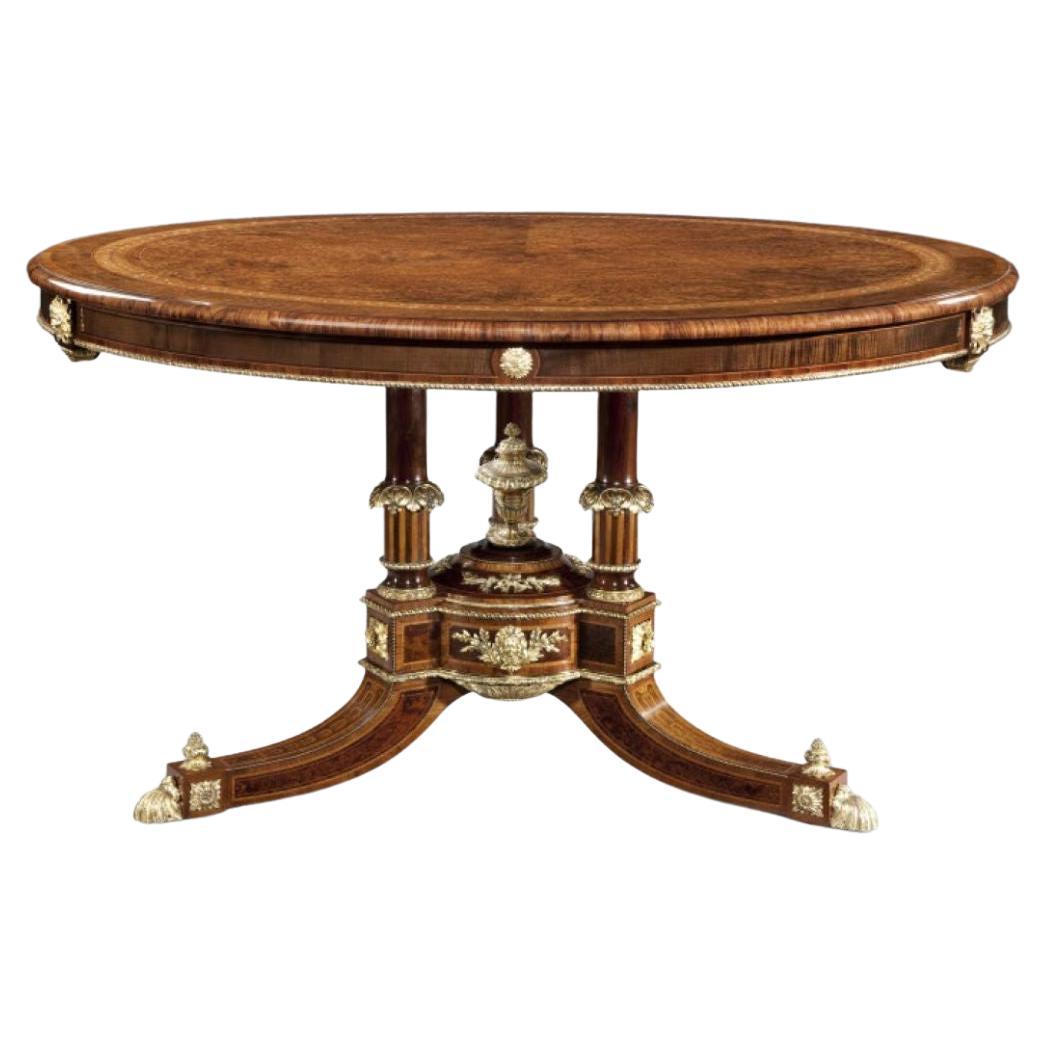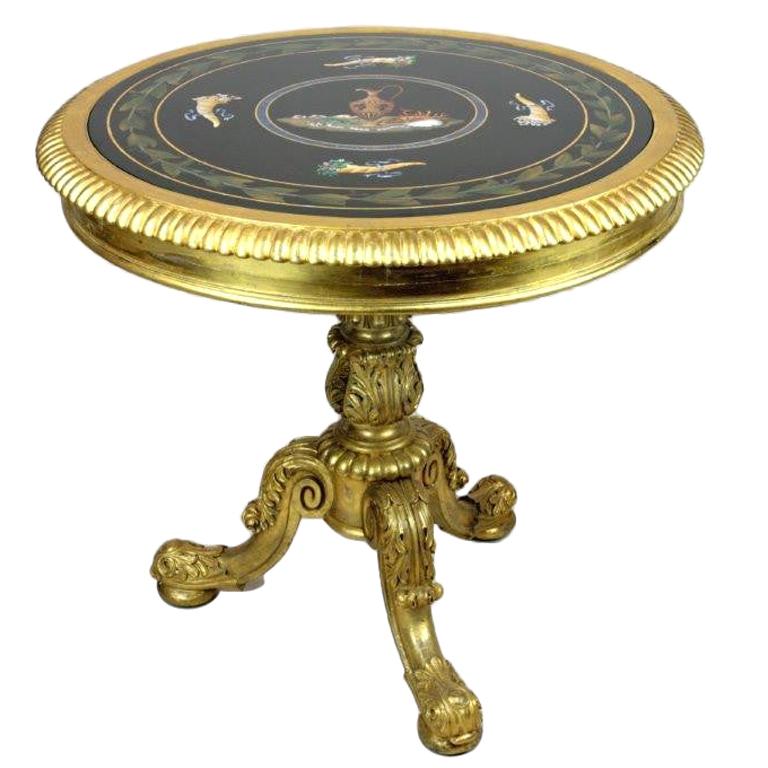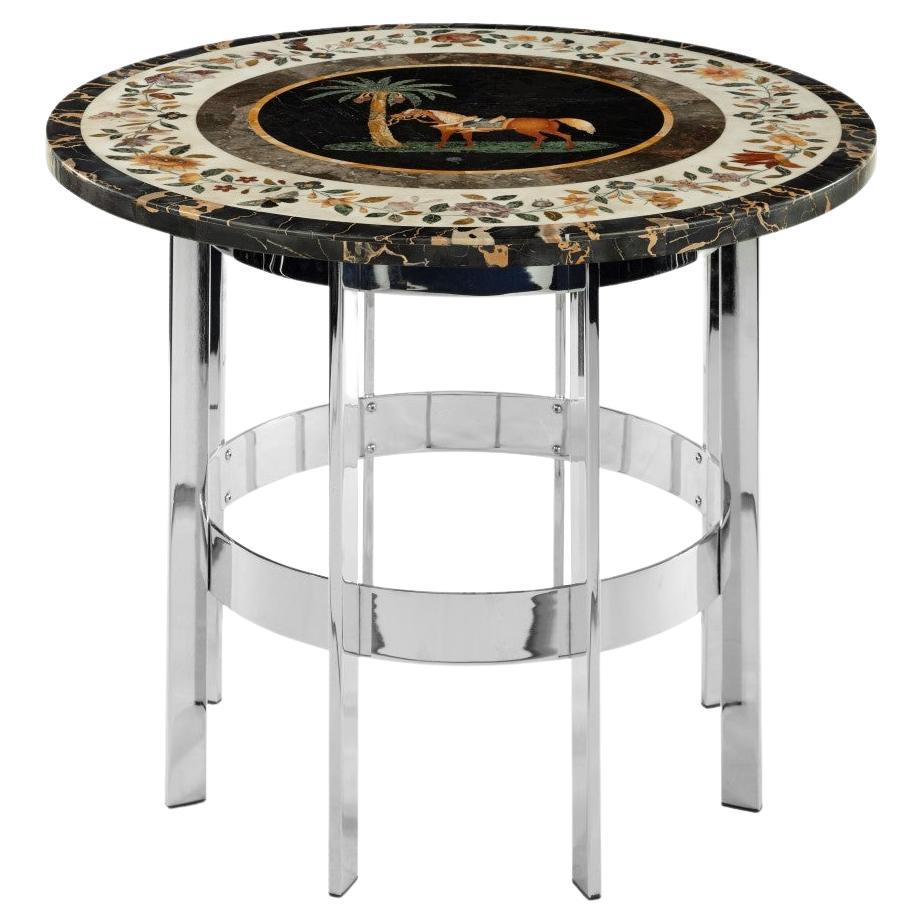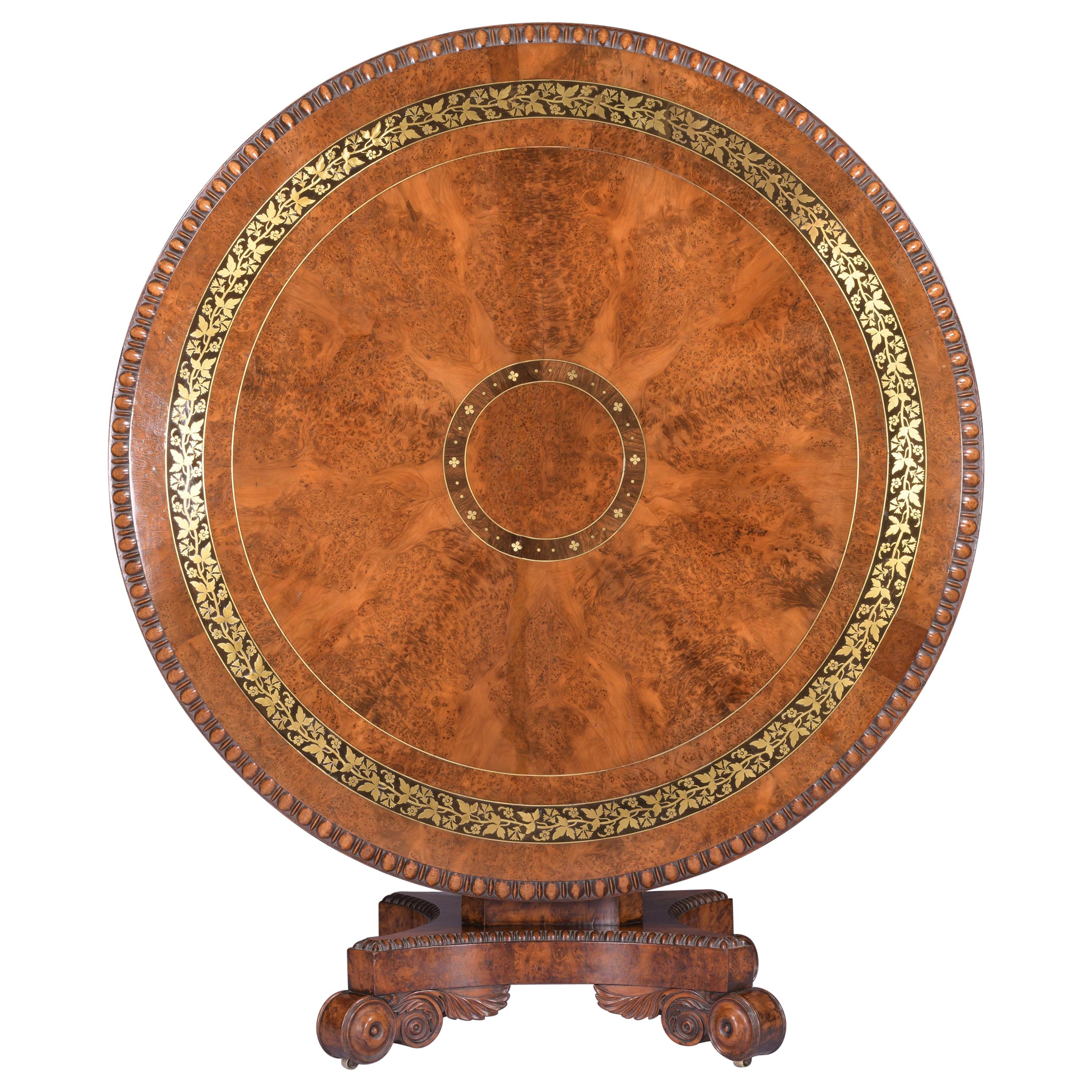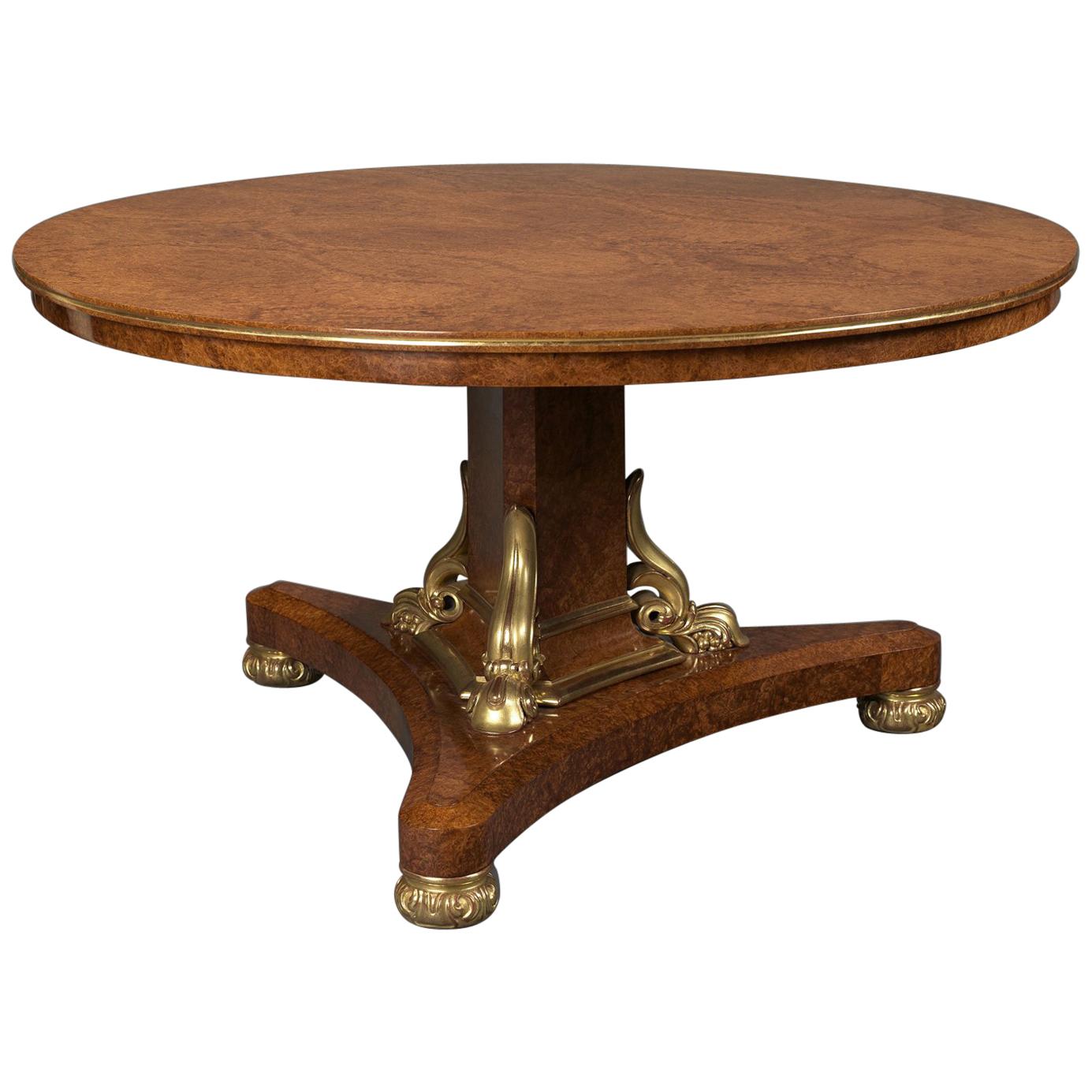Items Similar to Hungarian-Ash Centre Table Attributed to Holland and Sons
Want more images or videos?
Request additional images or videos from the seller
1 of 5
Hungarian-Ash Centre Table Attributed to Holland and Sons
About the Item
This exhibition quality table is attributed to Holland and Sons. The octagonal top is supported by four turned knopped legs, all joint by a solid shaped stretcher centred on an urn. The whole piece is decorated with the most exquisite marquetry in ebony, satinwood, boxwood and other contrasting woods and fine ormolu mounts. The top is vereered in Hungarian-ash within narrow bellflowers and guilloche borders. The legs and stretcher are embellished with further formal decorative moifs.
English, c1860.
H29”, diam 45”
Holland & Sons of London were first recorded in 1815 as Taprell and Holland. Under the management of William Holland, a relative of the famous Regency architect Henry Holland, they became cabinetmakers and upholsterer to Queen Victoria; their first commission being Osborne House in 1845. Granted the Royal Warrant in 1846, the company went on to supply Windsor Castle, Balmoral and also the new Houses of Parliament. In 1851 they exhibited at the Great Exhibition and were represented at all the major exhibitions thereafter.
- Dimensions:Height: 29 in (73.66 cm)Diameter: 45 in (114.3 cm)
- Materials and Techniques:Ash
- Place of Origin:England
- Period:1860-1869
- Date of Manufacture:circa 1860
- Condition:Wear consistent with age and use.
- Seller Location:Lymington, GB
- Reference Number:1stDibs: LU973016327372
About the Seller
5.0
Recognized Seller
These prestigious sellers are industry leaders and represent the highest echelon for item quality and design.
Established in 1982
1stDibs seller since 2013
Typical response time: 2 hours
Associations
LAPADA - The Association of Arts & Antiques Dealers
- ShippingRetrieving quote...Ships From: Lymington, United Kingdom
- Return PolicyA return for this item may be initiated within 14 days of delivery.
More From This SellerView All
- Centre Table Attributed to Holland and Sons Related to a Table in Clarence HouseLocated in Lymington, HampshireA centre table attributed to Holland and Sons related to a table in Clarence House, this exceptional table has a circular top decorated with six radiating amboyna veneers with a border of concentric marquetry rings. The decoration comprising kingwood bands within boxwood stringing, a continuous boxwood laurel wreath with ivory berries on a satinwood ground and further amboyna borders. The frieze has amboyna crossbanding and applied ormolu sunburst medallions. The support is composed of purpleheart columns inlaid with kingwood, terminating in low splayed feet, which encircle a classical urn on a plinth. The superb ormolu mounts include acanthus leaves, classical masks and patera. English, circa 1860. A table with a similar base and particularly fine ormolu mounts was exhibited by Holland and Sons in the International Exhibition in 1862 and illustrated as plate 40 in J. B. Waring’s book (see pages 100-103 for further references to this exhibition). A further closely related piece was in the collection of the late Queen Elizabeth the Queen Mother and is shown in the Morning Room in Clarence House in the Daily Mail’s article ‘Inside the private world of Prince Charles’, November 2018. Originally founded by Stephen Taprell and William Holland...Category
Antique 1860s English Center Tables
MaterialsBoxwood, Kingwood, Satinwood, Amboyna
- Late Regency Giltwood Centre Table Attributed to GillowsBy Gillows of Lancaster & LondonLocated in Lymington, HampshireA very attractive antique late Regency giltwood centre table attributed to Gillow of Lancaster and London, inset with an Italian Pietra Dura top, The central turned baluster supp...Category
Antique Early 19th Century English Regency Center Tables
MaterialsGiltwood
- Maltese Pietra Dura Table Top Attributed to Joseph Darmanin & SonsBy Joseph DarmaninLocated in Lymington, HampshireA Maltese pietra dura table top attributed to Joseph Darmanin & Sons, the circular top intricately inlaid with a central scene depicting a saddle...Category
20th Century English Tables
MaterialsMarble, Chrome
- Regency amboyna centre table, attr. to E H BaldockBy Edward Holmes BaldockLocated in Lymington, HampshireLate Regency Amboyna centre table, attributed to the workshop of Edward Holmes Baldock. The circular top with a shaped apron set upon a solid trif...Category
Antique 1830s English Regency Center Tables
MaterialsAmboyna
- Victorian Birch or Satinwood Writing Table, Attributed to Holland and SonsBy Holland & SonsLocated in Lymington, HampshireA Victorian birch or satinwood writing table, attributed to Holland and Sons, the leather-inset top with moulded edges above a disguised single frieze drawer, the end supports compri...Category
Antique 1880s English Victorian Desks and Writing Tables
MaterialsCeramic, Leather, Birch, Kingwood, Satinwood, Tulipwood
- Regency Rectangular Rosewood Tilt-Top Table Attributed to GillowsLocated in Lymington, HampshireA Regency rectangular rosewood tilt-top table attributed to Gillows, the rectangular top with bookmatched veneers set upon a shaped and reeded support with four splayed hip legs, Eng...Category
Antique 1810s English Tables
MaterialsRosewood
You May Also Like
- Exceptional 19th Century Centre Table Attributed to Holland & SonsBy Holland & SonsLocated in London, by appointment only• One of the finest pieces of 19th century English furniture ever made • Firmly attributed to the Royal cabinetmaker, Holland & Sons • Made using stunning rare & exotic timbers, Th...Category
Antique Mid-19th Century British Early Victorian Center Tables
MaterialsOrmolu
- English Regency Burr Yew Wood Centre Table Attributed To George BullockBy George BullockLocated in Dublin, IEAn exceptional Regency Burr Yew wood centre table attributed to George Bullock, the circular top having ebony strung segmented central panel and brass foliate scrolling floral marque...Category
Antique Early 19th Century English Regency Center Tables
MaterialsBrass
- George IV Centre Table Attributed to Thomas & George Seddon, circa 1830By Thomas & George SeddonLocated in Brighton, West SussexA Very Fine George IV Parcel-Gilt Amboyna Centre Table Attributed to Thomas & George Seddon. English, Circa 1830. The table is of finely figured Amboyna with a circular tilt-top above a triform column with parcel-gilt scrolled supports. It is raised on a conforming plinth base with foliate carved feet and concealed castors. George Seddon was the eighth child of John Seddon of Blakelea, Lancashire. His father apprenticed him to George Clemaphon of Cripplegate to learn cabinet making. He became a master cabinet maker. (He was Master of the Joiner’s Company in 1795). In the early 1750s he was sufficiently successful to acquire London House, Aldersgate Street. It consisted of extensive workshops, where furniture was made, and showrooms to display the finished products. London House had formerly been a palace of the Bishops of London. The panelled state-rooms were ideal for the display of fashionable furniture; and the chapel and library made convenient workshops. When Seddon married, he converted the garden house and infirmary into the family home. Seddon was the biggest furniture maker of his time. His furniture store covered a two acre site in Aldersgate Street. His workshop there was described by London visitor Sophie v. La Roche in 1786: "We drove first to Mr. Seddon's, a cabinet-maker,...He employs four hundred apprentices on any work connected with the making of household furniture—joiners, carvers, gilders...Category
Antique Early 19th Century English George IV Center Tables
MaterialsWood
- 19th Century Coromandel and Inlaid Table Attributed to Jackson & GrahamBy Jackson & GrahamLocated in London, GBA magnificent library table Attributed to Jackson & Graham Of free standing rectangular form, constructed in coromandel, with inlays in thuya, ebony, boxwood, and honeysuckle; the fluted legs rising from square brass castor-shod feet; the frieze housing two lockable drawers fitted with rare ‘tamper proof’ Chubb locks and having quadrant moulded cedar lined interiors; the platform having a central panel of beautifully chosen matched coromandel veneers, with an outer guard border of a running pattern of stylised anthemions; the ebony edges having a thumb nail moulding, circa 1865 The firm of Jackson & Graham established in 1836 by Thomas Jackson and Peter Graham at 37 Oxford Street London, and for the next fifty years produced predominately high quality furniture and represented Britain at many of the international exhibitions. Their clients included Queen Victoria, Napoleon III, the Grand Khedive of Cairo and the royal palace in Siam. They were particularly noted for their fine marquetry work, the use of Wedgwood plaques, rare woods, and fine casting of bronze mounts. They engaged the leading designers of the period, inter alia, Owen Jones, Bruce Talbert, Alfred Lorimer and Eugene Prignot. In the mid-1850s the workforce was recorded as 250, and by 1875, the company was employing 600 workers. They were feted exhibitors at many of the Great Exhibitions of the 19th century, and frequent prize winners. At the Paris International Exhibition of 1878, the furniture jury noted of them ‘ the workmanship is so perfect that even with the aid of a magnifying glass scarcely the slightest imperfection is to be found’. In 1885 the company was absorbed by Collinson and Lock, who continued their standard of excellence. Charles Chubb was apprenticed as a blacksmith before starting business as a ships’ ironmonger in Winchester. Jeremiah soon joined the business, and by 1818 the brothers had branched out into lockmaking, founding the famous Chubb Company. The business really got started when Jeremiah Chubb patented his new ‘detector lock’ in 1818. The lock was constructed so that if someone tried to pick it or open it with the wrong key it became inoperable. To make the lock work again the owner had to use a special key supplied with the lock. The aim of the detector lock was to prevent burglaries, and to warn the owner that someone had tried to break into their property. The lock soon became popular, and sales of the Chubbs’ products increased even more when they won a government competition to design a lock that could only be opened using its own key. After the invention of the detector lock, the Chubbs decided to move to Wolverhampton, which already had an established lock making industry. By 1838 they were making 28,000 locks a year at their Wolverhampton factory. Another product was added to the Chubb range in 1835 when a patent was taken out for a burglar resistant safe, and in 1837 the Chubb safe...Category
Antique 19th Century English Tables
MaterialsBrass
- French Marquetry Center Table attributed to Francois LinkeBy François LinkeLocated in Los Angeles, CAA magnificent antique gilt-bronze mounted mahogany, kingwood, satiné trellis parquetry, and satinwood marquetry center table attributed to Francois Linke. The circular parquetry top...Category
Antique 1890s French Louis XV Center Tables
MaterialsBronze
- Hardstone and Rosewood Centre Table Attributed to GillowsBy Gillows of Lancaster & LondonLocated in New Orleans, LAThis remarkable rosewood centre table attributed to legendary firm Gillows showcases masterful craftsmanship and stunningly rare hardstone specimens. The table's base is ornately crafted, complete with lion's paw feet, emphasizing the quality of the wood. The most impressive element of this beautiful piece of furniture, however, is the exquisite inlaid table top. Featuring eighteen semi-precious and hardstone specimens artfully arranged in alternating geometric shapes, rare stones like gem quality Lapis Lazuli, Egyptian porphyry and Siberian amethyst dazzle the eye. Other stones and specimens inlaid in square, circle and hexagon shapes include pyrite lapis lazuli, malachite, green aventurine, agate of amethyst, greek spartan porphyry, labradorite, fossilized wood, occhio di pavone, brèche verte d'égypte, sicilian jaspers, blood stone, spanish brocatelle, siena brocatelle, convent siena and nero antico. The sheer variety and superb quality of these features is an overwhelming visual delight and a triumph of craftsmanship. Hardstone pieces such as this were popular among the British aristocracy...Category
Antique 19th Century Regency Center Tables
MaterialsAgate, Amethyst, Lapis Lazuli, Malachite, Porphyry
Recently Viewed
View AllMore Ways To Browse
Ash Topped Table
Dutch Top Table
Hungarian Wood Furniture
Antique Dutch Table
Dutch Wood Table
Antique Narrow Table
Narrow Antique Table
Narrow Table Antique Furniture
Solid Ash Table
Table Dutch Legs
Holland House Antique Furniture
Holland And Son
Holland And Sons
Centre Table English
Record Table
Antique Architects Table
Architects Table Antique
Antique Architect Table
